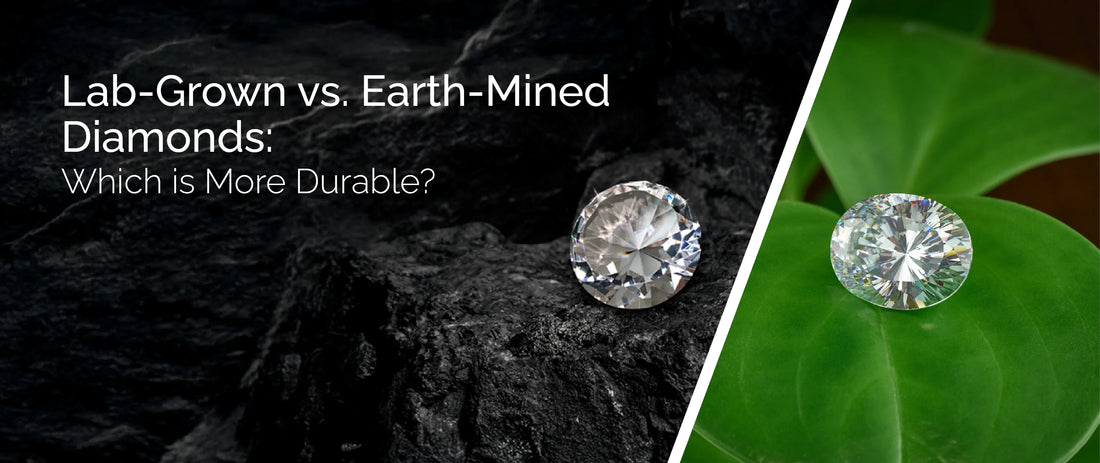
Are Lab-Grown Diamonds More Resistant Than Earth-Mined Diamonds?
Introduction
One of the very first things consumers ask themselves is how resistant lab-created diamonds are to earth-mined diamonds. It is because it is within their build, what they are composed of, and the way they have been built as far as overall hardness is concerned. This article will present the issue of the longevity of lab-created diamonds versus those extracted on our planet and provide the reasons why they are the final component to include in long-lasting jewellery.
Learning About Diamond Hardness
Gem mineral hardness follows the Mohs hardness scale from lowest (1) to highest (10). Cultured diamonds and natural diamonds both have a 10 and therefore both are the hardest naturally occurring material on the planet.
This hardness is very high, and diamonds are consequently scratch-proof. A diamond can scratch another individual diamond apart from it, and diamonds are consequently employed in industrial cutting tools. Such a similarity of natural and synthetic diamonds' properties aids towards pointing out that both are equally resistant to scratching and therefore suitable for daily wear of jewellery like pendants, bracelets, and rings.
Chemical and Physical Properties
Lab diamonds aren't diamond mimics such as Moissanite or cubic zirconia. Lab diamonds are real diamonds sharing the same physical, optical, and chemical composition as natural diamonds.
They differ only in the place they came to be:
● Natural diamonds were created millions of years ago deep inside the Earth under severe heat and pressure.
● Lab diamonds are produced in an A-list laboratory environment by cutting-edge technology that copies nature's crystallization process of diamonds.
There are two primary processes through which lab-created diamonds are made:
● High-Pressure High-Temperature (HPHT) – Nature replicates where carbon is pressed together and subjected to extremely high temperatures to form a diamond crystal.
● Chemical Vapor Deposition (CVD) – A process in which a blend of hydrocarbon gases is used to deposit carbon atoms onto a diamond seed, layer by layer, of a diamond.
Resistance to Chipping and Breaking
Even though diamonds are the hardest naturally occurring substance, they are not indestructible. Diamonds do possess something known as cleavage planes, internal structures where the atomic bonds are ever so slightly less strong. If hit extremely hard in the wrong direction, a diamond will chip or shatter.
Lab-grown and natural diamonds will also chip because they share the same crystal lattice structure. How much, depending upon the shape, cut, and mounting of the diamond, will be:
● Certain shapes, such as Princess and Marquise, with pointed corners will chip.
● Round cuts with rounded edges will not chip.
● Closed mounting, e.g., bezel or prong mounting, may minimize chipping.
Care and Maintenance
Cleaning and maintenance must be done to keep your lab-grown diamond jewellery in good condition. Some of the tips are as follows:
● Cleaning: Clean your diamond using warm water, mild dish soap, and a toothbrush with a soft bristle. Never use strong chemicals since they will weaken metal settings.
● Storage: Diamond jewellery must be stored separately so that it does not scratch. The best place for this is a case lined with jewellery and filled with soft padding.
● Periodic Inspections: If your diamond is in a ring or other type of jewellery worn frequently, have it taken to be inspected from time to time by a jeweler to have the setting in position.
● Impact Avoidance: Diamonds are resilient but ought not ever to be fallen on hard materials or metal by sudden blows.
Selecting Settings for a Long Life
Where you install a diamond determines how long-lasting it will remain. When setting a lab-made or a natural diamond, proper setting prevents harm from being brought about and gives way to an extended life. Optimal setting for longevity
● Bezel Setting: Metal encircles a rim that holds the diamond and shields it in complete cover.
● Six-Prong Setting: Six prongs instead of four leaves leave less room for movement on the diamond.
● Flush Setting: The diamond is level with the band, where it is shielded from shock.
Wearing and Durability
Lab-created diamonds are built to be tough, like natural diamonds. Since they are hard, they are appropriate for:
● Engagement rings
● Wedding rings
● High-quality jewellery such as studs, pendants, and bangles
Ethical and Sustainable Facets of Lab-Cultured Diamonds
Apart from being tough, lab-cultured diamonds also possess other qualities that will find favor with the new consumer:
● Conflict-Free: Traditional mining for diamonds is usually accompanied by unsafe working conditions. Lab-cultured diamonds do not suffer from this problem.
●Eco-Friendly: Diamond mining tends to have a ginormous environmental impact. Lab-cultured diamonds translate into zero land displacement and energy use.
● Affordability: Cultured diamonds are priced between 30-40% lower than comparable-quality natural diamonds, allowing customers to own a bigger or higher-quality diamond within their budget.
Conclusion
We at Espira Gems offer finer quality cultured diamonds that are stunning, durable, and eco-friendly. Browse through our beautiful collection now and discover the ideal jewellery piece that speaks of your personality and dreams!





